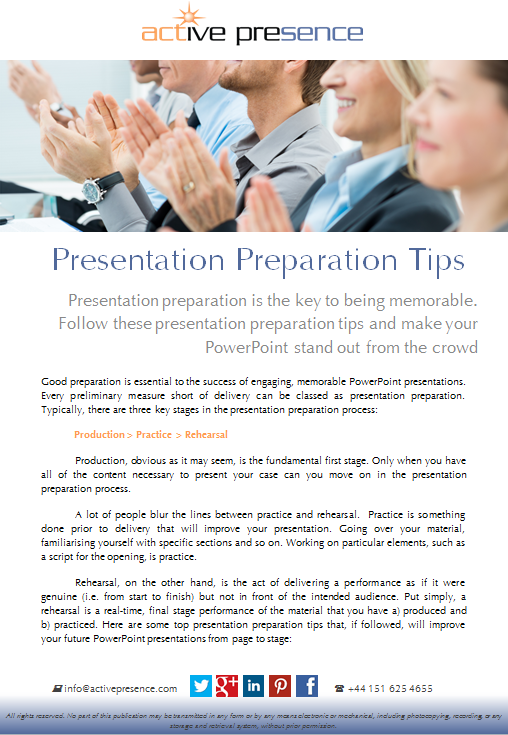Presentation Preparation Tips
Presentation preparation is the key to being memorable. Follow these presentation preparation tips and make your PowerPoint stand out from the crowd
Good preparation is essential to the success of engaging, memorable PowerPoint presentations. Every preliminary measure short of delivery can be classed as presentation preparation. Typically, there are three key stages in the presentation preparation process:
Production > Practice > Rehearsal
Production, obvious as it may seem, is the fundamental first stage. Only when you have all of the content necessary to present your case can you move on in the presentation preparation process.
A lot of people blur the lines between practice and rehearsal. Practice is something done prior to delivery that will improve your presentation. Going over your material, familiarising yourself with specific sections and so on. Working on particular elements, such as a script for the opening, is practice.
Rehearsal, on the other hand, is the act of delivering a performance as if it were genuine (i.e. from start to finish) but not in front of the intended audience. Put simply, a rehearsal is a real-time, final stage performance of the material that you have a) produced and b) practiced. Here are some top presentation preparation tips that, if followed, will improve your future PowerPoint presentations from page to stage:
Practice begins as a paper exercise. It is essential to ensure that the objectives of your performance meet the measurable expectations of your audience. Check that your objectives are reflected in your script and supporting graphics. Check that your script triggers graphics at exactly the right time for maximum audience impact. Check that you have your script marked up for points of emphasis, conflict, climax, and resolution. Make sure that you know when you should be speaking louder and when you should be speaking softer. Make sure that you've allocated enough pause time for the audience to decode and assimilate your message.
You should practice the first 200 words of your presentation (approximately) until they are committed to memory. Similarly, you should be reasonably tight with your close, so that upon the words, “…and so in conclusion ladies and gentlemen…” you know precisely how the remaining 30 seconds or so should go.
For your opening and closing segments, make sure that your words are unequivocally linked to your presence on stage – make sure that you know where you're going to stand when you deliver the bookend remarks. If your performance lends yourself to the format, why not deliver the open and close from exactly the same physical position on stage?
The most valuable aspect of effective rehearsal is to run from start to finish, without pause – regardless of how many things go wrong – just keep going, (there’s no audience there so it doesn’t matter). Knowing what worked and what didn’t on a full run through will feed back directly to the practice stage. You’ll know what work is needed and where. Also, rehearsing might give you additional ideas in terms of producing content that lends itself particularly well to the performance.
Like this page? Share it here...
All presenters know that good presentation eye contact is important for an engaged audience. This vital connection can give the presenter immediate feedback from the audience; are they listening, excited, interested or bored. With good presentation preparation you will be able to avoid a bored audience, deliver an engaging presentation and be prepared to close that important sale.

